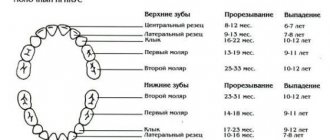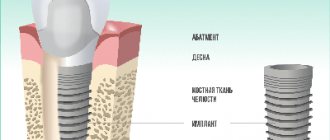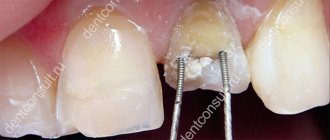What it is
If a person does not treat the tooth in a timely manner, the crown is destroyed. And sometimes this leads to the need for additional support to restore the tooth. A pin is used here if the roots are suitable for prosthetics. Thus, the dentition is not deformed and the jaw structure is preserved.
A pin is a structure that is fixed in the root canal. To install it, you need to meet certain conditions - 2 mm thickness of the root walls, it is possible to unseal the canal, completely seal it and give it the desired shape.
Application in dentistry
A pin is used quite often in dentistry to restore a tooth that has been damaged. But using a pin also:
- build up a tooth;
- prosthetics are used when it is not possible to attach a fixed prosthesis to neighboring teeth;
- reinforce the tooth where the pulp was removed;
- for splinting teeth in case of periodontal diseases;
- to perform replantation surgery.
Application
When the root canal is opened, stripped of root pulp and treated with mechanical files, the surface of the root dentin is exposed. Dentin constantly releases fluid into the lumen of the canal. While the canal is damp and damp, it is impossible to start filling it with gutta-percha, since there will be no tight sealing and chemical bonding of the filling material with the dentin.
In addition to the slight moisture content of the dentin, several milliliters of an antiseptic must be injected into the lumen of the root canal: chlorhexidine, hydrogen peroxide or sodium chloride. This is done to completely destroy microorganisms, but leaves the canal walls wet. Therefore, the problem of drying them necessarily arises.
Conventional drying methods, such as air blast from a dryer, are not acceptable in endodontics. The introduction of air under pressure can cause the bubble to escape into the periapical tissue and cause severe pain. Therefore, paper points come to the rescue in dentistry.
The drying method is extremely simple: the instrument is inserted into the canal to its full possible length for a few seconds and progressively advanced several times. It becomes completely damp, becomes unusable and is thrown away. This manipulation is carried out until an almost dry instrument is removed from the root lumen. After this, you can begin filling.
Some dentists use paper points to manually determine the quality of canal treatment: if your fingers feel a slight jamming sensation in the apex area, it means that the treatment was carried out efficiently.
Installation of a dental post
Several procedures are performed here:
- A treatment regimen is determined. The doctor tells how the pin will be installed, what material is best suited for the patient;
- The tooth is being prepared. It is processed and the filling, if any, is removed. In the case of a pin made of fiberglass or carbon fiber, the excess material is trimmed off. The rod is then fixed inside the canal using a composite;
- When the pin is fixed, the cement has hardened, and the part of the tooth that is the crown is restored. If the pin is on the front tooth, then you need to carry out artistic restoration so that it acquires a natural shade.
Clinical case
A 40-year-old female patient with severely damaged maxillary central incisors. There is a significant change in color. Both teeth had received inappropriate endodontic treatment. The left incisor has lost a significant part of its crown. The gum is hypertrophied and occupies the coronal cavity. (Fig. 1-3).
Rice. 1
Rice. 2
Rice. 3
The long-term joint work of the endodontist and orthopedist begins.
The hypertrophied gum was removed from the cavity using electrosurgery, and a rubber dam was then properly placed. The risk of bacterial infection due to the lack of a rubber dam increases with an additional root canal or insufficient apical obturation. (Goldfein J et al, 2013).
The existing endodontic filling was removed using a rotary system (Protaper Next, Dentsply Maillefer). The length of the root canal was checked using an apex locator (Proper II, Dentsply Maillefer) (Figures AB).
Immediately after removal of the root canal filling, automated root canal instrumentation was performed using the Protaper Next system (Dentsply Maillefer) (Figure C).
Washing was performed with 2.5% sodium hypochlorite solution. A suitable gutta-percha point was then selected for apical sealing (Figure D). (Fig. 4)
Rice. 4
A hybrid Tagger technique was used for root canal obturation.
Lateral condensation of gutta-percha points was enhanced using the Gutta Condensor device (Dentsply Maillefer). In this way, gutta-percha was thermally plasticized and compacted apically (Fig. 5).
AH 26 (Dentsply) was used as a root canal sealant.
Rice. 5
After trimming the gutta-percha points using hand instruments, vertical condensation of the endodontic filling was performed (Figures A and B).
Immediately thereafter, the root canal filling was partially removed to drill a hole for a post of the desired length using a Peeso No. 1 drill bit with a standard blue-rimmed pneumatic contra-angle (2000 rpm) (Figures C and D).
Simultaneous obturation and preparation of the bed for the pin reduces the likelihood of apical leaks and improves the quality of endodontic obturation. (Perdigao J, 2016) (Kim HR, 2017).
Removing the filling becomes easier if it is performed immediately after obturation of the root canal. No plasticizers are required for gutta-percha. Heating pluggers or an electronic thermal attachment can also be used for this purpose. (Perdigao J, 2016).
Because this is a collaborative workflow, there is no need to plan instrumentation of the pin site using X-ray or CT imaging. The orthopedist has all the information necessary for the job. Given the circumstances, the endodontist may be able to perform the entire procedure himself (Bertoldi Hepburn A, 2011).
Cleaning the dentinal walls of the post tray before inserting the post is also easier and faster if the post tray is prepared immediately after removing the filling from the canal. To ensure reliable apical sealing of the root canal, 6 mm of gutta-percha is left.
Rice. 6
The Macro-Lock Oval UPS system (RTD, France) was chosen.
After the Peeso drill No. 1, channel expanders were used. Four dilators corresponded to four pins of different sizes and with individual geometry modifications.
In this case, the drill bits used were No. 1 (yellow code), No. 2 (red code), and No. 3 (blue code). The #4 pin drills were green coded.
Canal expanders will ensure sufficient compatibility of the root canal with the shape of the post and, therefore, friction of the post and dentin, at least in the apical third of the root canal.
In many SWS systems, the shape and dimensions of the pin are not consistent with the channel expanders and holes for the pin. Differences in the shape and/or size of the post and its hole in the root canal can result in poor fit of the post and the appearance of gaps between the root canal filling material and the top of the post. (Portigliatti RP et al 2017).
To prevent the generation of heat due to friction with dentin, preparation of the post hole using channel expanders must be carried out in stages. Therefore, tooling must begin with the first drill.
However, in clinical cases similar to the one described, due to the need to treat the canal with rotating instruments during repeated endodontic treatment, which, in turn, increases the taper of the root canal, only drills No. 2 and 3 are used (the drill corresponded to the pin).
During root canal treatment, constant rinsing with a sterile water-based liquid (distilled water, saline solution, etc.) is recommended. (Bertoldi Hepburn A, 2011).
It is necessary to check whether the drills retain their cutting properties. The manufacturer indicates that these drills can be used 12-15 times.
One of the most important ways to prevent heat generation is to reduce the drill speed. To prevent heat generation, it is recommended to use a speed of 800-1200 rpm. Pneumatic micromotors are not suitable for use at these speeds as they lose torque. Electric micromotors are better because they can be precisely set to the appropriate speed and torque. In this clinical case, the x-Smart Plus endodontic motor (Dentsply, Maillefer) was used. It was applied at a speed of 1000 rpm and a torque of 3 Ncm.
After creating a hole for the post using channel expanders, it must be cleaned and sterilized.
Cleaning of the post bed was done with hand instruments, followed by the use of a conical interdental brush with distilled water/cleaning solution. For the final rinse, distilled water and alcohol were used to promote drying using sterile paper points. A microscope was used during cleaning. The microscope illuminates the pin bed and enlarges the operating space. Thus, the microscope helps control the cleaning process and contributes to a successful result.
Cleaning was easy and quick since the endodontic sealant had not yet cured. (Fig. 7).
Rice. 7
The selected SWS (Macro-Lock Oval No. 3) was pre-installed in the hole after disinfection in alcohol. The fit turned out to be very accurate. Friction between the tissues was evident and hence the post was stable and had high retention. There was no need to add any other materials to customize the pin and thus achieve reliable mechanical fixation. As can be seen in the photograph, the taper of the pin increases in the coronal part and gradually changes the round geometry to oval, thereby achieving friction and increasing the cross-section.
However, some clinical cases still require the use of additional materials (composite, fiber reinforcement, additional pins, etc.) to achieve proper mechanical fixation. In other clinical situations, good post fit may require adjustments to eliminate excess friction. To do this, you can use regular drills or diamond discs.
This SHS system uses Illusion technology (color coding), when the pins change color from yellow, red, blue and green depending on the pin number to the natural color of the tooth after installing the pin, and vice versa, if the surface is cooled to a temperature below 22 degrees using a cool water. This technology is designed to make it easier to locate a post in a composite core material in cases where the post needs to be removed to access the root canal.
An x-ray will be required to verify proper fit of the post.
At the end, the pin was cleaned with alcohol (35-40% phosphoric acid can also be used) and dried with dry and clean air. It is not necessary to apply any binders (silanes or composites) to the post if the fixation is with self-etching cement. With the standard protocol, resin is definitely needed. The pin is ready for cementing (Fig. 8).
Rice. 8
Self-adhesive (self-etching) cement (SmartCem 2, Dentsply) was used as a cementing material. Self-adhesive resin cements can be used without dentin adhesives, thereby facilitating cementation.
The effectiveness of simplified cementation of ultrasonic cement using self-adhesive polymer cements is described in several publications. (Hannau M et al, 2008) (Huber L et al, 2007) (Samah S & Özcan M, 2015). Although in reality there is no adhesion (mechanical fixation of the post will ensure its retention), self-adhesive polymer cements can create micromechanical and/or chemical bonding mechanisms between the post and dentin. (Hannau M et al, 2008).
Resin cement was injected into the pin hole from the apical end to the cervical approach using a fine injection tip. This procedure prevents the formation of air bubbles and ensures uniform distribution of the material inside the root canal. Lentulo channel fillers should not be used for this purpose.
Immediately after the injection of resin cement, a pin was inserted, which took its final position after three light pressures to squeeze out excess cement.
After removing the residue with a suitable brush, the material was photoactivated using a blue curing lamp for 1 minute on the buccal and lingual surfaces and directly above the post to illuminate the deepest parts of the post bed (Figure 9-11).
Rice. 9. A flowable opaque composite was used to fill the coronal part of the tooth. A clinical process similar to that described above was also performed for the adjacent central incisor during the second clinical session
Rice. 10. During the second clinical session, cores were formed and temporary crowns were made. The results of the procedure were monitored using x-rays.
Rice. eleven
The situations before and after surgery can be seen and compared on x-rays. SWS demonstrates proper integrity of the filling material in the root canal. There are no gaps between the endodontic filling and the post. The taper of the root canal that appeared after repeated treatment was almost completely preserved (Fig. 12).
Rice. 12
Temporary acrylic crowns are customized to enhance appearance.
A finely dispersed composite was applied to the buccal surface after grinding; the layering technique was performed using masses of varying chromaticity and brightness.
Then the final finishing and polishing was done. The crowns were cemented with temporary cement (Provicol, Voco GmbH) (Fig. 13).
Rice. 13
The aesthetic appearance of the temporary crowns turned out to be very natural, and the patient was satisfied with them.
During the second clinical session, restoration of the lateral incisors was also performed. The entire clinical process (both endodontic treatments, insertion of the CVS, core formation and creation of highly esthetic temporary crowns) was completed in two clinical sessions.
If a tooth hurts after installation, what should you do?
When a damaged tooth is restored, tissue may be destroyed. Therefore, sometimes the patient feels that the treated tooth hurts. If there was no pain before the procedure, and the tooth has been depulped for a long time, then the pain may arise due to the fact that the canal was entered too deeply. Then it is worth taking an x-ray to determine the cause of the pain.
It happens that pain occurs due to an allergy to a certain material. It can also manifest itself as deterioration of the condition, hyperemia, stomatitis.
General classification of pins
Standard pins (pins theoretically designed to fit into any root). They are used for installation in slightly damaged teeth, if the level of destruction is above the gum. When installing a standard pin, it is necessary to adjust the tooth root to the pin using special tools. Standard pins can be metal or non-metal. Of the metal pins, today the best are titanium pins. They can also be made of steel, copper, brass and other metals. The pins can be plated with gold, but this does not give them any advantage. The pin set may be supplied with tools to install them. This option is much more convenient for the doctor, and is important for the patient because the installation accuracy is higher. You can ask your doctor how he plans to place the pin for you - using a set of tools or regular dental equipment. The first one will be preferable. Best choice: A titanium post made by a reputable manufacturer that includes the tools to install the post. In Family Dentistry, for example, standard pins from Maillefer (Switzerland) are used. Non-metallic pins are usually made by reputable companies and come with installation tools. They are installed less frequently, since the scope of application of these pins is insignificant. The advantage of non-metallic pins is their light transmission, which allows them to be used for highly artistic restorations, as well as as a basis for all-ceramic crowns (metal pins are completely lightproof). Family Dental uses non-metallic pins from the American company Bisco.
Individual pins or pin stump inlays. They are made taking into account the internal relief of the root of a particular tooth. Individual pins are more reliable than standard pins and are able to be held in complex roots. Their cost is more expensive, which is due to the complexity of manufacturing, in the process of which a dental technician is involved. Individual pins are made from the same metal from which the crown will be made, since the golden rule of prosthetics using metal is “The presence of one metal in the mouth.” Individual pins can be removable. This option is used on severely damaged chewing teeth, which will bear significant loads after restoration. A detailed explanation of their features will be discussed below, in examples of work done at Family Dental. Thus, we can summarize the features of individual pins (pin stump inlays):
- excellent reliability;
- the possibility of manufacturing from the same material as the crown material (gold-platinum alloy, titanium, cobalt-chromium alloy, etc.);
- Possibility of manufacturing from fiberglass for purely ceramic restorations (no metal);
- Possibility of use in severely damaged teeth with thin walls or with a level of destruction below the gum;
- the ability to make them collapsible if it is not possible to go deep into only one canal, and the tooth, after restoration, will bear a significant load.
Flaws
With the help of pins, you can restore even a tooth that is almost completely destroyed. But there are certain disadvantages of this design and its application:
- if there are errors in the manufacture of the pin, the tooth may then deteriorate faster and complications may arise;
- If it is necessary to remove the pin, then all materials are removed from the roots. After all, the pin is locked tightly;
- an allergy to the material can provoke a reaction in the body;
- Since the walls of the tooth are subjected to stress, they become thinner. And this destroys the tooth and does not allow it to be restored.
What is a pin
What is a dental pin for teeth and why is it placed? A pin is an artificial element that is placed in a damaged tooth and allows it to be strengthened before subsequent prosthetics or before splinting a group of teeth. A dental post1 looks like a small nail, rod, or toothpick and can be hard or flexible. It can also be threaded. What are such structures made of? Nowadays dentists have a very large selection of materials – metals and alloys, ceramics, gutta-percha and others, we will tell you in more detail below.
Interestingly, restoration with a pin lies on the border of therapeutic dentistry (conservative treatment) and orthopedic dentistry (prosthetics). That is, if installation is necessary, you can contact both a dentist and an orthopedist.
Complex on 4 OSSTEM implants with delayed loading - from RUB 170,000.
Complex implantation Osstem (South Korea) with delayed loading after 4-6 months.
Guarantee for the doctor’s work - unlimited Call now or order a call
Opening hours: 24 hours a day - seven days a week
Contraindications for installation
Contraindications for the use of pins are related to how damaged the walls and roots are, how thick the walls of the tooth are, how long the canals are, how obstructed they are, and whether there is inflamed, damaged periodontitis tissue. Also, the structure cannot be installed if there are granulomas, cysts, caries, or other diseases.
Before placing a pin, a specialist must examine the tooth that was damaged, clean the canals, and take an x-ray. If the length of the root is less than the height of the dental crown, then such a procedure cannot be performed. The walls must be 2 mm thick, otherwise the load on the tooth will be very large, as a result of which it will simply begin to collapse. In addition, the tooth root must have good stability.









